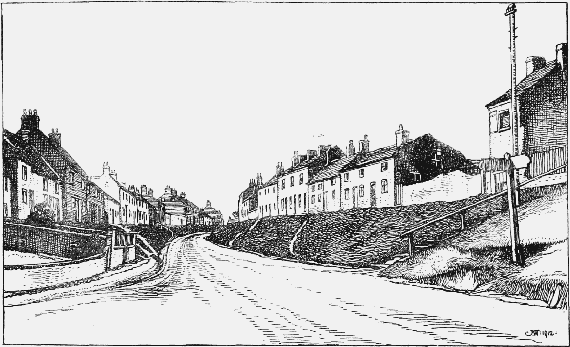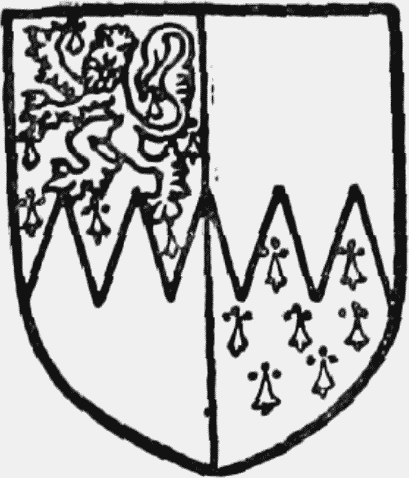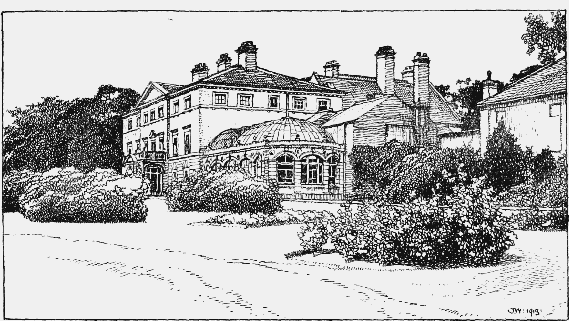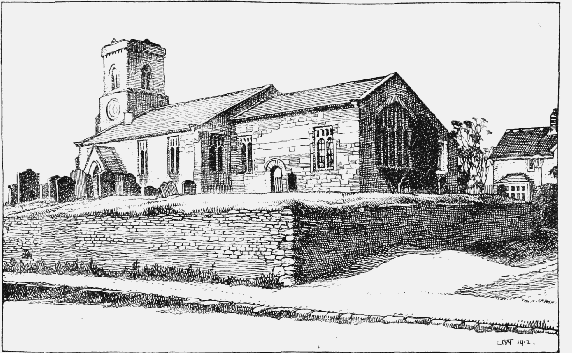A History of the County of York North Riding: Volume 2. Originally published by Victoria County History, London, 1923.
This free content was digitised by double rekeying. All rights reserved.
'Parishes: Stillington', in A History of the County of York North Riding: Volume 2, (London, 1923) pp. 187-190. British History Online https://www.british-history.ac.uk/vch/yorks/north/vol2/pp187-190 [accessed 18 April 2024]
In this section
STILLINGTON
Stivelincton (xi cent.).
The parish of Stillington covers 2,157 acres, of which 1,076 acres are under cultivation, 724 acres are laid down to grass, and 178 acres are woodland. (fn. 1) The soil is sand and clay on a subsoil chiefly of middle lias. Corn and potatoes are grown. The village lies along the road from Easingwold to Sheriff Hutton. The road from York to Helmsley joins this road at about the middle of the village street; it turns at a right angle along that street and passes northward again by taking another right-angled turn across the green at the east end of the village. There is a Wesleyan chapel here. The church occupies a central position on the north side of the broad village street. The village, though of some size, is bare and uninteresting, and the houses are all of comparatively recent date.
To the east of the village and opposite the green lies the Hall, the property and residence of Mr. M. Liddell, with a fair-sized park, in the extreme south west corner of which is a chalybeate spring called St. John's Well. To the west lies the extensive common land, in which is Cass Plantation divided from the Fox Covert by Shand Lane. Ings Lane runs north and south through the water meadows or Ings, in which stand Little and Big Ings Wood divided by Ings Drain which becomes eventually Hawkhills Beck. The whole parish is well watered.
Almost the entire northern portion of Stillington is known as Northskeugh. Skarregarth, Chapel Land, Long Blackwall Flat, Blailand Flat, Pease Ing Flat and Crayke Park Field (fn. 2) are place-names mentioned in 1649. The River Foss waters the eastern portion of Stillington for a short distance and turns the mill, which at the time of the Domesday Survey was valued at 3s. (fn. 3)

Stillington Village
A description of the prebendal manor given in 1295 (fn. 4) mentions two water-mills and one windmill. The bondmen then gave merchet and paid 'oyerwycht' and heriots. (fn. 5) All the bondmen carried their tithes of sheaves to the prebendary's grange and timber for building, and in harvest time they all reaped for one day. The holdings varied from 1 to 4 oxgangs.
The name of Laurence Sterne (fn. 6) is closely connected with the village of Stillington. In March 1742–3, soon after his marriage, he was instituted to the living in fulfilment of a promise made to his wife by Lord Fairfax. (fn. 7) Sterne held it in conjunction with Sutton, where he lived for nearly twenty years, conducting the morning service at Sutton, and walking across the fields to Stillington in the afternoon to preach his weekly sermon, unless other attractions presented themselves en route. One Sunday no vicar appeared to conduct the afternoon service, and the parishioners afterwards discovered that a covey of partridges raised by his pointer had engrossed the attention of their pastor. (fn. 8) So unpopular was he with his parishioners that they would render him no assistance when he was nearly drowning through the ice breaking under him while skating on one of the ponds at Stillington. It was to him that the people of Stillington owe an Act inclosing 1,400 acres in 1766. (fn. 9) He surrendered the tithes of wool and lambs and received in compensation a share in the common land. Sterne had a great admirer in the squire, Stephen Croft, who was perhaps the first to see Tristram Shandy. It was at Stillington Hall that Sterne threw the manuscript of his famous novel into the fire on finding it unappreciated by Croft's friends after a heavy dinner; Croft himself rescued it from the flames.
In 1660 (fn. 10) Henry Bridgeman, afterwards Bishop of Sodor and Man, was appointed to the prebend of Stillington, which he held amongst various other benefices, though he appears never to have lived there.
Manor
In 1086 and before this date STILLINGTON formed part of the possessions of the Archbishop of York, (fn. 11) who held there 10 carucates at geld. Before 1258 (fn. 12) a prebend had been formed and endowed with the manor, which was extended in 1295 (fn. 13) at 3 carucates of arable land in demesne and 20 acres of demesne meadow, with three messuages and 36 oxgangs held by certain rents. The manor continued in the hands of the prebendary and was in the Liberty of St. Peter. (fn. 14) In 1616 a lease or assignment was made to William Ramsden, (fn. 15) and in 1625 (fn. 16) Christopher Croft had a lease of it for a term of three lives. In 1649 the Parliamentary trustees for the sale of the lands belonging to the Dean and Chapter of York sold the manor to George Gill of Leeds; he in the same year sold it to Christopher Croft, (fn. 17) who appears to have obtained a grant of it from the dean and chapter after the Restoration. He was Lord Mayor of York in the time of Charles I, (fn. 18) and was knighted on the occasion of his entertaining that monarch at his own house. He married first Cecilia the daughter of James Welford, (fn. 19) prebendary of Stillington, and secondly Elizabeth Harrison. By his second wife he had a son Thomas Croft, (fn. 20) who married Olive, only daughter and heir of John Dyneley of Bramhope. Thomas Croft was followed by a son of the same name, who died in 1711, (fn. 21) leaving a son Stephen. On his death in 1733 (fn. 22) he was succeeded by his son Stephen Croft, the friend of Sterne. He died in 1798, (fn. 23) leaving a son Stephen, who held the manor of Stillington in 1799 (fn. 24) and died in 1813, (fn. 25) being followed by Colonel Harry Croft, who died in 1853. (fn. 26) He left two sons; Harry, the elder, was drowned at Balaclava in 1854, and Stillington passed to Stephen, his younger brother. On his death in 1871 (fn. 27) he was succeeded by his son Harry Croft, who sold the estate in 1895. The Hall and some 275 acres were bought by Mr. Rawdon Thornton, and were sold by him in 1903 to Mr. Matthew Liddell, the present owner. (fn. 28)

Croft of Stillington. Quarterly indented erminois and gules with a leopard rampant gules in the quarter.

Stillington Hall
In 1543 (fn. 29) Edward Archbishop of York was granted land in Stillington which had formerly belonged to Moxby Priory.
Church
The church of ST. NICHOLAS consists of a chancel 32¼ ft. by 16 ft. with north vestry, nave 44¼ ft. by 16 ft. with side aisles, making a total width of 33½ ft., west tower and south porch. The total length is 87¾ ft., and the measurements are all internal.
The church was so largely rebuilt and altered in 1840 that little indication of its history is left. None of the existing features, however, are older than the 15th century, to which period the chancel and north vestry belong. The nave and tower are said to have been rebuilt in 1840, but probably much of the old work was re-used and much left in situ. At that date the nave and aisles were included under one roof, and the chancel roof follows the same pitch.
The chancel has a five-light east window with a traceried four-centred head, and in the south wall are two square-headed two-light windows, also traceried in the head. Between the last two is a priest's door, and further east in the same wall is a plain piscina. The chancel arch dies into the wall on either side. The vestry on the north side is of 15th-century date with a single-light square-headed east window. The nave and aisles are four bays long, the arcades springing from octagonal piers without capitals. The aisles are lit by square-headed two-light windows similar to those in the south wall of the chancel. The roofs all date from 1840, and the curious corbels to the flat aisle roofs are probably also of that date. In the third bay on the south side is a shallow porch with a pointed outer doorway.
The tower at the west end is of three stages with diagonal buttresses at the angles rising to the base of the belfry. The walls of the belfry stage are set back considerably on the exterior and are each pierced by a pointed two-light window of 15th-century character. The plain parapet is corbelled out, and in the centre of each side is a diminutive gablet.
In the east window is a small fragment of ancient glass inscribed IHC.
The tower contains three bells; the first inscribed 'Exultabo in deo, 1698'; the second, in black letter, '+ Sancta ihc Maria ihc Hora ihc pro nobis'; the third 'Deo gloria, 1732.'

Stillington Church from the South-east
The plate includes a cup (York, 1634 ?) inscribed 'William Willkinson, Robert Morlay, Chourchwardens of Stillinton, 1664'; the remainder of the pieces are modern.
The registers before 1812 are as follows: (i) mixed entries 1666 to 1702; (ii) mixed entries 1703 to 1778, marriages to 1753 only (on a flyleaf of this book are signatures of Laurence Sterne, vicar, 1744 and 1767); (iii) marriages 1754 to 1812; (iv) baptisms and burials 1778 to 1812.
Advowson
Stillington is a peculiar (fn. 30) and a discharged vicarage. It was formerly a rectory belonging to the prebend of Stillington, to which stall it was appropriated and a vicarage ordained about 1520–30. (fn. 31) The patronage is now in the hands of the archbishop.
Charities
In 1654 Jane Rawdon left a cottage-house and yard to the poor with a share of common upon the West Moor containing about 17 acres. The land is let at £12 5s. a year.
In 1713 William Cook left to the poor 5s. to be paid every St. Thomas's Day out of his allotment in the Roobers, and in 1715 Alice Cook left to poor widows the sum of 5s. out of the same property.
These charities are administered together under a scheme of 28 August 1891, as varied by a scheme of 21 May 1897 for the general benefit of the poor, chiefly in the distribution of coal.
In 1836 John Calvert by will bequeathed £100 to be invested and the income applied for the benefit of poor widows. The legacy was invested in £102 13s. 11d. consols (with the official trustees). The dividends, amounting to £2 11s. 4d., are applied in gifts of money varying from 3s. 6d. to 7s. 6d.
